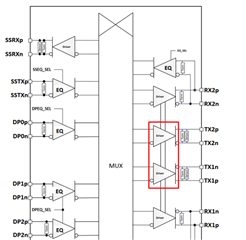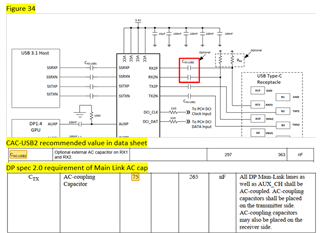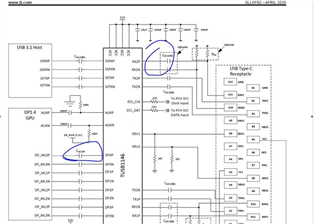Tool/software:
Hi Expert,
A critical problem need your help to confirm, if TX[1:2]P/N( downstream port ) support to tune TX emphasis by I2C manually when configured as USB3.0 TX.

Thanks
Han
This thread has been locked.
If you have a related question, please click the "Ask a related question" button in the top right corner. The newly created question will be automatically linked to this question.
Tool/software:
Hi Expert,
A critical problem need your help to confirm, if TX[1:2]P/N( downstream port ) support to tune TX emphasis by I2C manually when configured as USB3.0 TX.

Thanks
Han
Han
No, the downstream paths will always operate in linear redriver mode, so there is no SWING or Emphasis control for TX1 and TX2.
Thanks
David
Hi David,
Thanks for your confirm. Could you help with below question raised by customer?
Referring to figure 34 of datasheet, it recommends the value of this cap within the range from 297nf to 363nf.
When TX2P/N and RX2P/N configured as DP port, I checked the DP spec, the recommend value of AC cap is in range 75nf to 265nf, I can’t find a value meet both DP and datasheet requirement, so CAC-USB2 is USB port only?
Customer's concern is if the CAC-USB2(330nF) will impact the DP compliance test when RX2P/N or RX1P/N is configured as part of DP port since the AC cap should be in the range in range from 75nf to 265nf defined by DP SPEC.

Han
But for DP Alt Mode over Type-C, there will be a capacitor at the sink or device side as shown below.

The capacitor at the sink or device side will be 100nF or 220nF.
With 330nF on one side and 100nF or 220nF on the other side, the total capacitance is = 1/ (1/330 + 1/100) = 76nF. The 220nF will push the total capacitance a bit higher, but both 100nF and 200nF will ensure the capacitance is within the DP spec requirement.
Thanks
David
Hi David,
Customer said that the compliance test should pick up signal at the type-c connector? Please help to double confirm.

Hi Han,
David's on travel so I'll help to support this. You are correct that the compliance test sees the signal coming from the type-C connector. When you run compliance, you will use a breakout fixture to connect the TX1/2 and RX1/2 lines to the oscilloscope running the test:

For USB TX compliance, you only need to connect one TX pair to the oscilloscope.
For DP compliance, you need to connect all four TX/RX pairs to the scope as well as the AUX/SBU lines.
Best,
Shane
Hi Shane,
Thanks for your backup. But the customers concern is actually the AC caps on the two sides of the TUSB1146. If the capacitor value will be too large or too small that exceed the PD specification. Can you double check on that?

Thanks
Han
Hi Han,
It's ok to have capacitors on both sides of the TUSB1146. Each side of the 1146 should be treated independently, not as a single line. This means in an actual system application you're ok as long as:
I see your concern with the RX1/RX2 capacitors being too large when compliance is taken at the USB-C port. I believe the compliance test would be ok given that we recommend these capacitor values for type-C applications, but let me follow up with my senior colleague when he's back in the office on Monday to be sure.
Best,
Shane
Hi Han,
I followed up on this concern with our systems engineer. There should be a USB-C DP alt mode compliance test that factors in the 330nF capacitors on the RX lines. Like you mentioned, capacitors on the RX lines must be between 297nf to 363nf.
If you're running the USB-C DP Alt-mode compliance test, there should be no issue with these capacitors.
Best,
Shane
Hi Shane,
Really appreciate your clear explanation. That is very helpful.
Thanks
Han